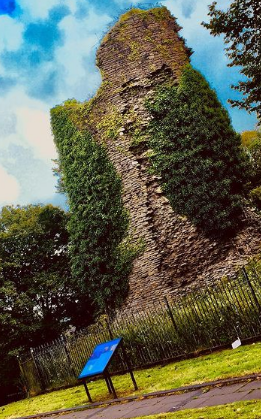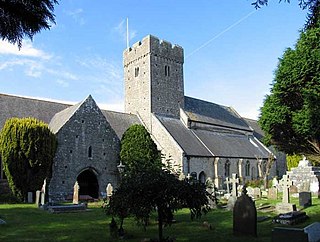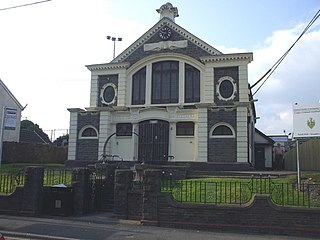
The Vale of Glamorgan, locally referred to as The Vale, is a county borough in the south-east of Wales. It borders Bridgend County Borough to the west, Cardiff to the east, Rhondda Cynon Taf to the north, and the Bristol Channel to the south. With an economy based largely on agriculture and chemicals, it is the southernmost unitary authority in Wales. Attractions include Barry Island Pleasure Park, the Barry Tourist Railway, Medieval wall paintings in St Cadoc's Church, Llancarfan, Porthkerry Park, St Donat's Castle, Cosmeston Lakes Country Park and Cosmeston Medieval Village. The largest town is Barry. Other towns include Penarth, Llantwit Major, and Cowbridge. There are many villages in the county borough.

Samson of Dol was a Welsh saint, who is also counted among the seven founder saints of Brittany with Pol Aurelian, Tugdual or Tudwal, Brieuc, Malo, Patern (Paternus) and Corentin. Born in southern Wales, he died in Dol-de-Bretagne, a small town in north Brittany, and was the nephew of Athrwys ap Meurig.

Llantwit Major is a town and community in Wales on the Bristol Channel coast. It is one of four towns in the Vale of Glamorgan, with the third largest population after Barry and Penarth, and ahead of Cowbridge. It is 4+1⁄2 miles (7.2 km) from Cowbridge, 9 miles (14 km) from Bridgend, 10 miles (16 km) from Barry, and 15 miles (24 km) from Cardiff. It had a population of 9,530 in 2021.

Llantrisant is a town in the county borough of Rhondda Cynon Taf, within the historic county boundaries of Glamorgan, Wales, lying on the River Ely and the Afon Clun. The three saints of the town's name are SS. Illtyd, Gwynno, and Dyfodwg. Llantrisant is a hilltop settlement, at an altitude of 174 m (571 ft) above sea level. The town is home to the Royal Mint.

Paul Aurelian was a 6th-century Welshman who became first bishop of the See of Léon and one of the seven founder saints of Brittany. He allegedly died in 575, rumoured to have lived to the age of 140, after having been assisted in his labors by three successive coadjutors. This suggests that several Pauls have been conflated. Gilbert Hunter Doble thought that he might have been Saint Paulinus of Wales.

Illtud, also known as Illtud Farchog or Illtud the Knight, is venerated as the abbot teacher of the divinity school, Bangor Illtyd, located in Llanilltud Fawr in Glamorgan, Wales. He founded the monastery and college in the 6th century, and the school is believed to be Britain's earliest centre of learning. At its height, it had over a thousand pupils and schooled many of the great saints of the age, such as David, Samson of Dol, and the historian Gildas.

Pontypridd is a constituency represented in the House of Commons of the UK Parliament since 2019 by Alex Davies-Jones of the Labour Party.

Saint Cadoc or Cadog was a 5th–6th-century Abbot of Llancarfan, near Cowbridge in Glamorgan, Wales, a monastery famous from the era of the British church as a centre of learning, where Illtud spent the first period of his religious life under Cadoc's tutelage. Cadoc is credited with the establishment of many churches in Cornwall, Brittany, Dyfed and Scotland. He is known as Cattwg Ddoeth, "the Wise", and a large collection of his maxims and moral sayings were included in Volume III of the Myvyrian Archaiology. He is listed in the 2004 edition of the Roman Martyrology under 21 September. His Norman-era "Life" is a hagiography of importance to the case for the historicity of Arthur as one of seven saints' lives that mention Arthur independently of Geoffrey of Monmouth's Historia Regum Britanniae.

St Illtyd's Church is a church complex in Llantwit Major, Vale of Glamorgan, southeast Wales. It is located at the site of the oldest college in the United Kingdom, once believed to have been founded as Côr Tewdws c. AD 395 by the Roman Emperor Theodosius II. It is now generally accepted as having been founded by St. Illtud c. AD 508, from whom it derives its name. The current church building was built in the 11th century by the Normans, with portions being rebuilt in the 13th and 15th centuries. The church building is one of the oldest and best-known parish churches in Wales. It is a grade I listed building, or building of exceptional interest, and has been called both the "Westminster Abbey of Wales" for its unique collection of carved stones and effigies, and "the most beautiful church in Wales."
Dyfodwg, or Tyfodwg, was a 6th-century Welsh saint. He is one of the three saints from whom the ancient parish of Llantrisant takes its name, and possibly the patron of the parish church of Llandyfodwg in Glynogwr, between Blackmill and Gilfach Goch in Bridgend, and gave his name to the ancient parish of Ystradyfodwg.
South Glamorganshire was a parliamentary constituency in Glamorganshire, Wales. It returned one Member of Parliament (MP) to the House of Commons of the Parliament of the United Kingdom, elected by the first past the post system.
Côr Tewdws or Bangor Tewdws is a fictional Romano-British ecclesiastical college that in the 18th and 19th centuries was understood to have been the predecessor of the historically attested 6th century College and Abbey of Saint Illtud at what is now Llantwit Major in Glamorgan in Wales. The supposed Roman college is believed to have been invented by the historian of ill-repute, Edward Williams, more generally known as Iolo Morganwg.

Llanwonno is a hamlet high up on the eastern side of Cefn Gwyngul, in the hills between the historic mining valleys of the Rhondda and the Cynon in Rhondda Cynon Taf, deep in the heart of the South Wales Valleys. Llanwonno today consists of St Gwynno's Church and an inn – The Brynffynon Hotel.
Llantwit Fardre is a large village and community situated on the A473, Pontypridd to Bridgend, road near the Welsh towns of Pontypridd and Llantrisant. Llantwit Fardre is also the name of the old parish and the community area that takes in the villages of Llantwit Fardre, Tonteg and Church Village. It is in the county of Rhondda Cynon Taf.

Church Village is a large village in the historic parish and community of Llantwit Fardre, located within the Taff Ely district of the County Borough of Rhondda Cynon Taf in Wales. The village is centrally located being around 4 miles (6.4 km) from the local principal towns of Llantrisant to the southwest and Pontypridd to the north and is situated approximately 8 miles northwest of Cardiff city centre.

John Prichard was a Welsh architect in the neo-Gothic style. As diocesan architect of Llandaff, he was involved in the building or restoration of many churches in south Wales.

Llantrisant Church is located in Llantrisant, Rhondda Cynon Taf, Glamorgan, Wales. Built within a short distance of Llantrisant Castle, it was originally in the Norman style of architecture. When described in History of Llantrisant, Glamorganshire (1898), little of the original church remained, with the only traces of Norman architecture being the baptismal font, a portion of the south door, and the lower part of the western arch of the nave. The tower, which is about 70 feet (21 m) high, contains a peal of six bells. The living is a vicarage. Llantrisant Church is a Grade II* listed building.

St Cadoc's Church, Llancarfan is a church in Llancarfan, in the Vale of Glamorgan, south Wales. It dates from the 13th century and has been a Grade I listed building since 28 January 1963.

Rhidian was a 6th-century Welsh Pre-congregational Saint who is often associated with St Illtyd.
St Illtyd's Church may refer to any of several churches in Wales dedicated to Illtud, also known as Illtyd:















